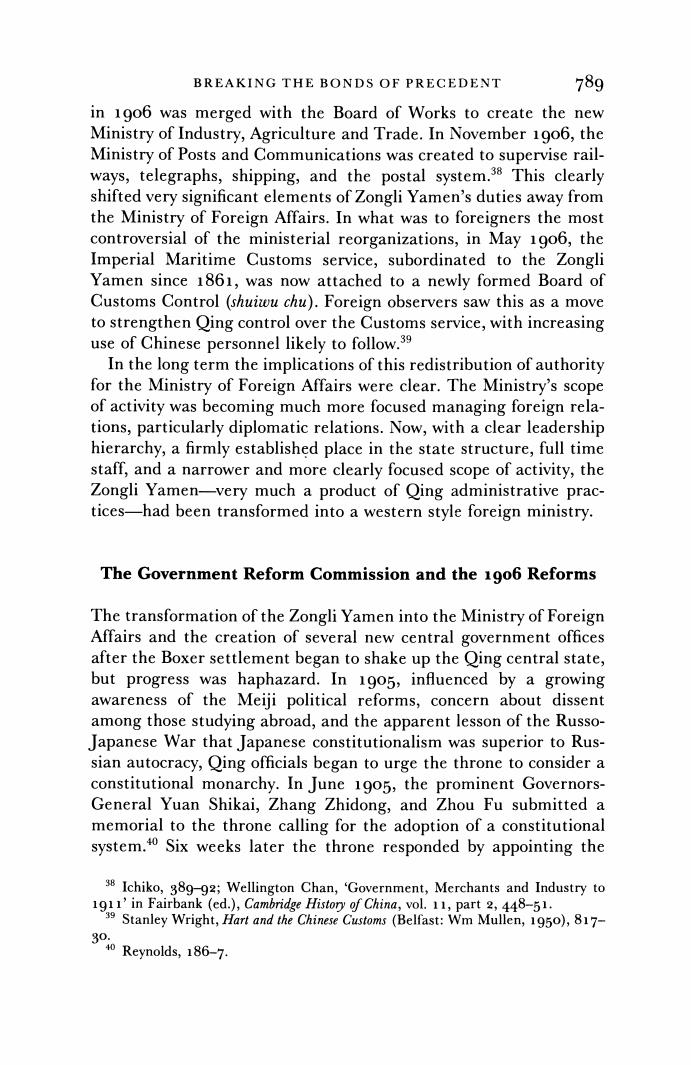正在加载图片...

BREAKING THE BONDS OF PRECEDENT 78g in 1906 was merged with the Board of Works to create the new Ministry of Industry,Agriculture and Trade.In November 1906,the Ministry of Posts and Communications was created to supervise rail- ways,telegraphs,shipping,and the postal system.38 This clearly shifted very significant elements of Zongli Yamen's duties away from the Ministry of Foreign Affairs.In what was to foreigners the most controversial of the ministerial reorganizations,in May 1906,the Imperial Maritime Customs service,subordinated to the Zongli Yamen since 1861,was now attached to a newly formed Board of Customs Control (shuiwu chu).Foreign observers saw this as a move to strengthen Qing control over the Customs service,with increasing use of Chinese personnel likely to follow.39 In the long term the implications of this redistribution of authority for the Ministry of Foreign Affairs were clear.The Ministry's scope of activity was becoming much more focused managing foreign rela- tions,particularly diplomatic relations.Now,with a clear leadership hierarchy,a firmly established place in the state structure,full time staff,and a narrower and more clearly focused scope of activity,the Zongli Yamen-very much a product of Qing administrative prac- tices-had been transformed into a western style foreign ministry. The Government Reform Commission and the 19o6 Reforms The transformation of the Zongli Yamen into the Ministry of Foreign Affairs and the creation of several new central government offices after the Boxer settlement began to shake up the Qing central state, but progress was haphazard.In 1905,influenced by a growing awareness of the Meiji political reforms,concern about dissent among those studying abroad,and the apparent lesson of the Russo- Japanese War that Japanese constitutionalism was superior to Rus- sian autocracy,Qing officials began to urge the throne to consider a constitutional monarchy.In June 1905,the prominent Governors- General Yuan Shikai,Zhang Zhidong,and Zhou Fu submitted a memorial to the throne calling for the adoption of a constitutional system.40 Six weeks later the throne responded by appointing the 8Ichiko,38992;Wellington Chan,Government,Merchants and Industry to 1911'in Fairbank (ed.),Cambridge Histor of China,vol.11,part 2,448-51. 39 Stanley Wright,Hart and the Chinese Customs (Belfast:Wm Mullen,1950),817- 30. 40 Reynolds,186-7.BREAKING THE BONDS OF PRECEDENT 789 in 1906 was merged with the Board of Works to create the new Ministry of Industry, Agriculture and Trade. In November 19o6, the Ministry of Posts and Communications was created to supervise railways, telegraphs, shipping, and the postal system.38 This clearly shifted very significant elements of Zongli Yamen's duties away from the Ministry of Foreign Affairs. In what was to foreigners the most controversial of the ministerial reorganizations, in May 1906, the Imperial Maritime Customs service, subordinated to the Zongli Yamen since 1861, was now attached to a newly formed Board of Customs Control (shuiwu chu). Foreign observers saw this as a move to strengthen Qing control over the Customs service, with increasing use of Chinese personnel likely to follow.39 In the long term the implications of this redistribution of authority for the Ministry of Foreign Affairs were clear. The Ministry's scope of activity was becoming much more focused managing foreign relations, particularly diplomatic relations. Now, with a clear leadership hierarchy, a firmly established place in the state structure, full time staff, and a narrower and more clearly focused scope of activity, the Zongli Yamen-very much a product of Qing administrative practices-had been transformed into a western style foreign ministry. The Government Reform Commission and the 19go6 Reforms The transformation of the Zongli Yamen into the Ministry of Foreign Affairs and the creation of several new central government offices after the Boxer settlement began to shake up the Qing central state, but progress was haphazard. In 1905, influenced by a growing awareness of the Meiji political reforms, concern about dissent among those studying abroad, and the apparent lesson of the RussoJapanese War that Japanese constitutionalism was superior to Russian autocracy, Qing officials began to urge the throne to consider a constitutional monarchy. In June 1905, the prominent GovernorsGeneral Yuan Shikai, Zhang Zhidong, and Zhou Fu submitted a memorial to the throne calling for the adoption of a constitutional system.40 Six weeks later the throne responded by appointing the 38 Ichiko, 389-92; Wellington Chan, 'Government, Merchants and Industry to 191 1' in Fairbank (ed.), Cambridge History of China, vol. 1 i, part 2, 448-51. 39 Stanley Wright, Hart and the Chinese Customs (Belfast: Wm Mullen, 1950), 817- 30. 40 Reynolds, 186-7